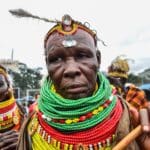The Great Blue Turaco in Uganda is one of the African bird species you would likely to see during your safari in Uganda either bird watching tour or wildlife safaris. It is a toraco a group of African near-passerines and the largest species of toraco. Generally the Great Blue Toraco is 70-75 cm in length with a mass of 850- 1230 grams.
The blue and its yellow tail feathers of the Great Blue Turaco are prized for making good luck talismans; it is resident of all most of the part in the country Uganda and is highly breeder in Kibale forest national park.
The adult has turquoise-blue upperparts, including wings and tail is long and wide and show abroad, black subterminal band.
Most of the birds have narrow blue tips. The outer retraces are partially edged yellow; the wings lack the crimson primaries of other turacos. On the underparts, neck and upper breast is turquoise-blue lower breast and belly is greenish-yellow, as the under-tail feathers.
The tail has black sub terminal band, lower belly under tail- coverts and tibial feathers are chestnut. On the turquoise-blue head, there is a conspicuous blue-black raised crest on fore crown and crown.
Behavior: Living is very social, either in small family groups or large flocks of up to 30. They forage in groups during day but roost on their own. Monogamous and territorial, they aggressively defend their home range from other turaco and predatory raptors.
It is not unknown, he says, for females to give up part way through the 22 day incubation period, or come off their eggs – usually two in number – too frequently, resulting in dead-in-shell.
Most turacos are medium-sized birds – an exception being the large great blue turaco – with long tails and short, rounded wings. They range in length from 40 to 75 cm (16–30 in). Their flight is weak, but they are strong climbers and are able to move nimbly on branches and through vegetation.
Types of fruits to include Turacos are primarily frugivorous, meaning their diet consists mainly of fruit. Some fruits that can be offered to turacos include papaya, mango, banana, apple, pear, grapes, berries and insects like white aunts. It’s essential to provide a variety of fruits to ensure they receive all the necessary nutrients
It returns to the feeding areas every day. The large fruiting trees may attract several groups; these birds live in social groups of about 5 to 25 birds.
The Great Blue Turaco is very agile for climbing into the tree branches and moves rapidly in trees, they are also shy birds and rarely come down to the ground except to the bath and drink some water.
Chin, throat cheeks and outer eye-ring are grayish. The large convex bill is bright yellow with red tip, the eyes are reddish-brown, surrounded by bare dark turquoise-blue aye-ring. Legs and feet are blackish.
Both sexes are similar with females are slightly larger than the males and the juveniles are duller. It has greyer breast and shorter crest.
Both adults build a platform with a shallow rim made with dry sticks, the nest is placed in tall leafy tree between 10 to 24 meters above the ground and often over water.
The female usually lays two pale blue eggs which are almost spherical; both parents incubate during the period of 22 to 24 days. The chicks are continuously attended by parents at nest during 27 to 29 days. They fed by both parents often assisted by a helper.
At four weeks of age the young ones climb around the nest and are able to make short flights in the tree at 27 to 33 days. They leave the nest at the age 5 to 6 weeks after hatching but parents remain with them until they are able to fly better, the young are still fed up to three months.
The Great Blue Turaco can stay in wild for about 25 years.








